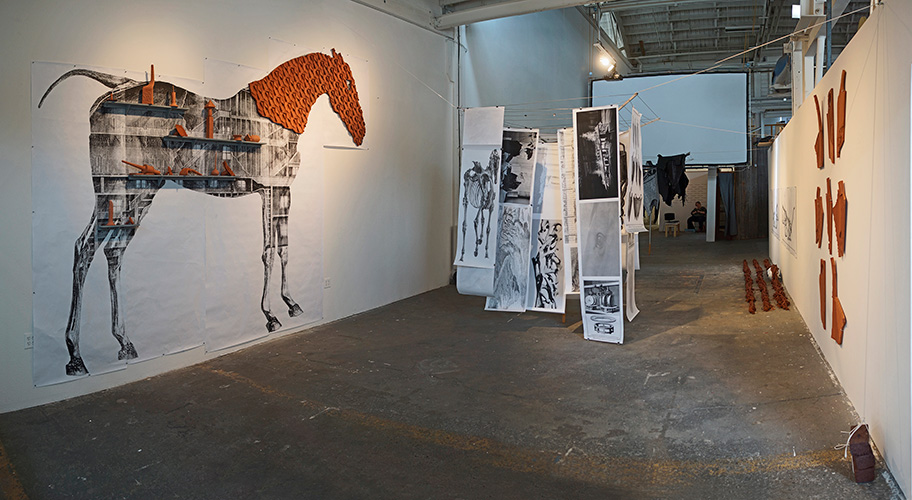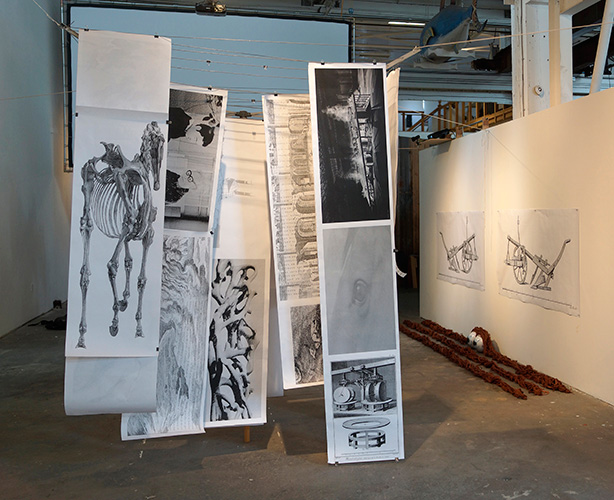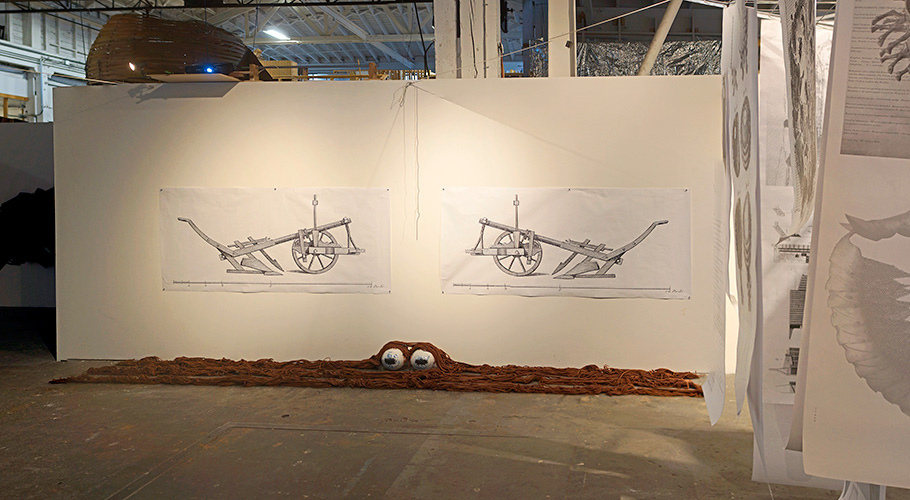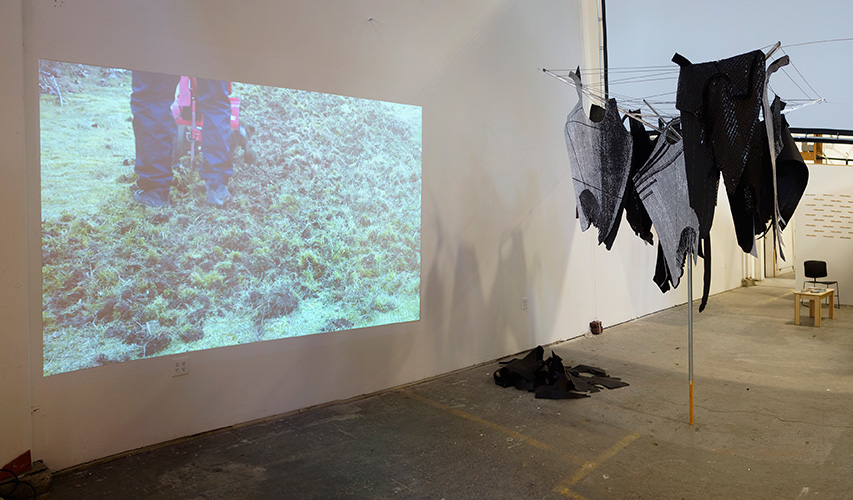Majores fertilissium in agro oculum domini esse dixerunt.
Our fathers used to say that the master’s eye was the best fertilizer.
Pliny the Elder—Historia Naturalis. XVIII. 84. 17
When tillage begins, other arts follow. The farmers, therefore, are the founders of human civilization.
Daniel Webster—Remarks on Agriculture, Jan. 13, 1840. P. 457.
I relate my approach to homeopathy, which puts poison in the system in order to generate energy to defeat the weakness.
The artist, Gustav Metzger, date unknown.
…artworks are a constellation of forces that are not organized in a single unified format, and that contradictions should remain unresolved in the artwork.
Theodor Adorno, ‘Aesthetic Theory‘.
Enchanted with a mysterious pattern from Diderot’s Encyclopedia and the story of the Trojan Horse, Forrest and Roloff aspire to a logos of craft, site, ceramics and knowledge.
Neil Forrest/John Roloff – NCECA 2017 Statement
Project Description:
Beginning with images and spirit of “Tailleu de Corps" (patterns for garments to be worn under armor) from Denis Diderot and Jean le Rond d’Alembert’s, Encyclopédie, ou dictionnaire raisonné des sciences, des arts et des métiers (Encyclopaedia, or a Systematic Dictionary of the Sciences, Arts, and Crafts), 1751-1772, we compiled historical data with our own ideas to build a contemporary encyclopedia and meta-ceramic archive. Ranging from an ancient alphabet to 21st century technology, a 17th century lace-makers awl in terra cotta to video animation, industrial enlargements of 19th century horse imagery to appropriations of contemporary art, organized as a series of integrated ‘elements’ installed through out the space. The exhibition took on a logos and life with agricultural/bibliographic/laboratory overtones.
As a structural foundation to this exploration are Encyclopedia Clothes Line and Pattern Clothes Line, two suburban clothes line structures held in place, in part, by UW Brick Counterweight elements, bricks of fired Puget Sound sediment from the soil of the ceramic facility at University of Washington (thank you Michael Swaine), occupied the central atrium of the exhibition. Suspended from the lines of the Encyclopedia Clothes Line element at the entrance were exploratory, exemplary, “pages” from our expanded knowledge system including: Forrest and Roloff’s earlier NCECA projects (2009 and 2014) and personal work, children’s drawings of horses, landscape, armor, contemporary French art/architecture (Huyghe/Le Corbusier video still). A few pages were digitally enlongated to accentuate the hanging, dripping and drying of “clothes” from the wash. Occasional images were overlayed with text in English and “Sumerian” cuneiform characters. One page is of intertwined lines from a rock and roll song by Noel Engle song and Virgil’s description of the delivery of the Trojan horse by the Greeks to Troy. The rear Pattern Clothes Line element held “pages” of tar- paper, geo-textile and paper cut-out patterns of different scales. Negative shapes from the pattern cutting were on a pile on the floor near-by with additional tar-paper patterns thickly collaged on an adjacent wall.
On the south wall of the exhibition space is Trojan Horse element, a industrial print on paper mural of a large “Trojan” horse re-conceptualized as a library with terra cotta objects as “books” or “knowledge” extracted from Diderot images on shelves. The horse’s head was sheathed in armor of tessellated terra cotta tiles derived from Diderot patterns. The Trojan horse image was a compilation of a George Stubbs drawing of a horse without skin and inner structure of Lucy, the Coney Island/Atlantic City effigy elephant hotel. Adjacent to the Trojan horse one found, D/F/R Project Laboratory of projected video, a collage of clips from Forrest/Roloff’s projects: Bunhead Square, 3-image Forrest studio project; clip from Deluge (Radiant Sleep/Helium Ash) by Roloff; Atomizer clips from Forrest’s studio; Expanded Ceramics, tillage video from University of WA, Roloff and Swaine; and an architectural animation of Diderot images (hidden by technical problems).
At the right upon entry one finds, Tailleu de Corps element, a series of reduced scale terra cotta interpretations of the “Tailleu de Corps” patterns and the UW Brick Counterweight elements. Further down the same wall, Plow/Trojan Horse Eye/Furrow element, two, reverse facing plow industrial prints on paper from Diderot, on the floor beneath, two enlarged horse eyeballs of glazed terra cotta at the scale of a hypothetical Trojan horse over 40 ft tall, extruded wet terra cotta string groups arranged as “furrows,” left to dry and break over the course of the exhibition. Further down yet one finds the Pattern Wall element, like Pattern Clothes Line element, of tar paper, geo-textile and paper elements with additional terra cotta ‘tools’ and rolled drawings.
Of the numerous transformations suggested by our assemblage, in the spirit of Pliny, Webster and Adorno, and like the Trojan Horse of antiquity, the idea of knowledge in unexpected forms as a secret invasion force housed in an “offering” to the powers that be, begins to suggest an inverted, homeopathic strategy, like Gustav Metzger’s, for ceramics of the 21st century.
Acknowledgments for Exhibition Support and Assistance:
Avarda Center for the Arts, sponsorship
Jackie Branson, video
Ceramics Department University of Washington, students, faculty and staff, video and plow site
Sarah Chenoweth Davis, installation
Julian Covey, fabrication, rhino
Emily Decario, fabrication
Clare Halpine, video
Mel McKinley, installation
Thomas Orr, support
Eliot Park, logistics
Sheila Provazza, fabrication
Michael Swaine, contributor and support
Mudshark Studios, logistics
Jacob & Maxwell Nadelberg, contributors
Additional thanks to:
NCECA and the Portland Site Hosts
San Francisco Art Institute
Nova Scotia College of Art and Design (NSCAD) |











